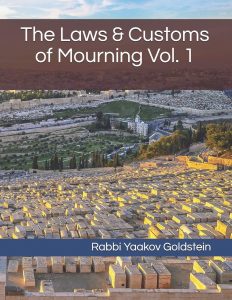10. After the immersion/Nine Kavin:
When to say the prayers:[1] Some say the prayers recorded in Mavor Yabok only after performing the washing and Taharah of Mikveh, or nine Kavin. Others, however, say it during the actual washing. [Some Gedolim were accustomed to instructing that they receive Malkus and “Daled Misos Beis Din” after the Taharah process and immersion in the Mikveh.[2]]
Drying the body:[3] After the immersion or pouring of nine Kavin, the body is immediately wrapped in a clean and dry sheet[4], and placed on the Taharah board where the entire body is dried. Some are accustomed not to use the Taharah board but to use a different board.[5] The board is to have a sheet placed on it prior to resting the body on it.[6]
Positioning the body:[7] After the Taharah, the body is to be positioned facing the opening of the room, and is not to be replaced in the same area in which the Taharah took place.
Protecting from touch: One is to be very careful after the Taharah that a gentile does not touch the deceased.[8] Likewise, a Baal Keri or Nida is not to touch the body.[9]
Not to turn over the Taharah board: One must be very careful not to turn over the Taharah board from the side that the body rested during the Taharah, as there is a danger in this matter.[10] After the burial, the board may be overturned.[11]
Washing hands:[12] [Immediately] after the Chevra Kadisha completes the Taharah process, they are to wash their hands [three times inconsecutively[13], being that the evil spirits escorts the person until he washes his hands[14]].
_________________________________________________________________________
[1] Nitei Gavriel 44:24
[2] Gesher Hachaim 9:4
[3] Gesher Hachaim 9:4; Darkei Chesed 11:13; Nitei Gavriel 45:9-10
[4] Gesher Hachaim 9:4 and Nitei Gavriel 45:10; not recorded in Darkei Chesed
[5] Nitei Gavriel ibid
[6] Sefarim ibid
[7] Tzavas Rav Yehuda Hachassid 6; Beis Lechem Yehuda 362; Kneses Hagedola Y.D. 362; Chochmas Adam 157:8; Kitzur SHU”A 197:6; Aruch Hashulchan 362:8; Darkei Chesed 12:15; Pnei Baruch 4:13; Nitei Gavriel 45:12
[8] Radbaz 1:507 regarding Taharah; Mishmeres Shalom Ayin 7; Nitei Gavriel 40:2; 45:19
[9] Seder Hillel Hazakein brought in Lechem Hapanim 362:4; Nitei Gavriel 45:19
[10] Tzavas Rav Yehuda Hachassid 18; Beis Lechem Yehuda 362; Chochmas Adam 157:8; Kitzur SHU”A 197:6; Aruch Hashulchan 362:8; Darkei Chesed 11:13; Nitei Gavriel 45:11
[11] Shivim Temarim on Tzavah ibid; Beir Moshe 8:111; Nitei Gavriel 45:11
[12] Admur Kama 4:18 that one who touches a corpse is required to wash his hands one time afterwards; Nitei Gavriel 44:17
[13] Elya Raba 4:12; Machatzis Hashekel 4:17; Soles Belula 4:14; Machazik Bracha 4:6 in name of Makor Chaim; Ben Ish Chaiy Toldos 16; Kaf Hachaim 4:61; M”B 4:39; Ketzos Hashulchan 2 footnote 29 regarding Levaya; Olas Tamid; Shlah Shaar Haosiyos 9; Lev Chaim 1:63; Kaf Hachaim [Falagi] 7:26; Ruach Chaim 4:3; Chesed Lealafim brought in Kaf Hachaim 4:61; Piskeiy Teshuvos 4:25 footnote 241
Background: Kama 4:18; M”A 4:17; Seder Hayom; Kneses Hagedola all rule that one is not required to wash three times. Nevertheless, the custom today has become to follow the opinions brought above.
[14] M”A 4:20 in name of Teshuvos Maharil; This applies according to all. See Halacha 2 in footnotes.


Leave A Comment?
You must be logged in to post a comment.